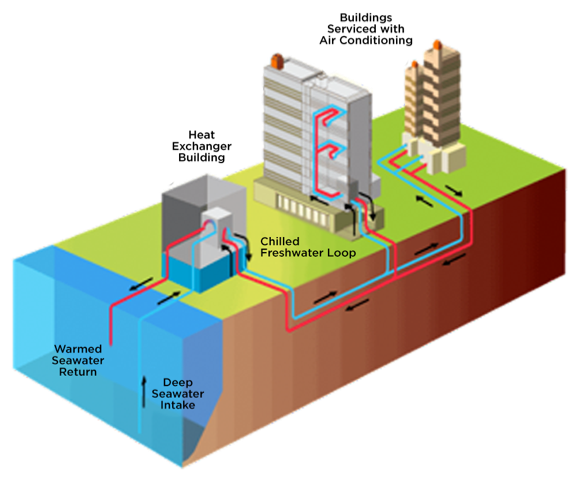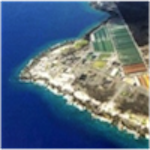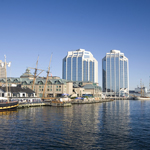SEAWATER AIR CONDITIONING
SEAWATER AIR CONDITIONING
Seawater Air Conditioning (SWAC) technology produces air conditioning without the use of chemical agents. Acting alone, SWAC can reduce electricity usage by up to 90% when compared to traditional air conditioning systems. When developed in conjunction with Ocean Thermal Energy Conversion (OTEC) plants, it operates entirely without the use of fossil fuels.
An environmentally responsible technology, SWAC plants use less fresh water and reduce environmental impact when compared to traditional air conditioning methods. SWAC systems are ideally suited for large commercial operations such as resorts, hospitals, airports, shopping centers, and even entire cities.

HOW IT WORKS
SWAC plants range in size from 400 to 80,000+ tons of cooling capacity, and draw millions of gallons of cold water from an ocean or lake to act as a cooling agent for large-scale air conditioning. As the cycle completes, it can be combined with a nearby desalination plant to provide fresh water.SWAC IS EFFICIENT
- SWAC is environmentally responsible, and reduces carbon emissions by 80-90%
- With an endless supply of cool ocean water, this revolutionary cooling technology is available 24 hours a day, 7 days a week, 365 days a year
- Our equipment is built to last 50 years, and is easy to operate and maintain
- SWAC reduces reliance on fossil fuels, as well as the need for chillers or cooling towers
- By reducing energy consumption and carbon emissions by up to 90%, SWAC dramatically cuts energy costs, which remain stable throughout the life of the contract
- SWAC runs on clean energy from local resources, which keeps money spent on energy in the local economy
HISTORY OF SWAC
The Natural Energy Laboratory of Hawaii Authority (NELHA) developed Seawater Air Conditioning in the 1980s while conducting research and development for Ocean Thermal Energy Conversion (OTEC). Using the same underwater pipes to draw cool water from the depths of the ocean, NELHA concluded that it could develop chemical free air conditioning while offering significant savings when compared to conventional practices.
The pipes placed in the Pacific Ocean off the coast of Kona still function and continue to provide cooling for the NELHA buildings today. A proven technology with years of global success, SWAC systems are currently running all over the world.
SWAC PLANTS AROUND THE WORLD

Nassau, Bahamas
Ocean Thermal Energy Corporation (OTE) has finalized the design and project development efforts for a large SWAC system for the new Baha Mar resort in The Bahamas. We have signed a 20-year contract (known as an Energy Service Agreement “ESA”) to supply seawater cooling to five hotels and a 100,000-square foot casino. OTE has already installed all of the SWAC pipework on the land side of the resort.

Bora Bora, French Polynesia
The InterContinental Resorts and Thalassa-Spa on the island of Bora Bora uses a SWAC system in conjunction with a deepwater spa. Learn more here.

Toronto, Canada
The Enwave Energy Corporation developed a Lake Water Air Conditioning (LWAC) system in Lake Ontario in 2004. An integrated district cooling system, it covers Toronto's financial district and has a cooling power of 59,000t as well as the capacity to cool 3,200,000 m2 of office space. It is currently the largest system in North America. Learn more here.

Halifax, Canada
The world’s first SWAC system has been operational since 1986 at Purdy’s Wharf, and cools a 700,000 square foot office complex. An additional system at Alderney 5 became operational in February 2010, cooling a 330,000 square foot office building. Reports show that the two systems save $400,000 annually when compared to traditional air conditioning systems.

Hong Kong, China
Closed Loop SWAC systems are operational at both the Excelsior Hotel and the HSBC office tower in Hong Kong.
Amsterdam, The Netherlands
In the spring of 2006, a district cooling system was completed to cool the Zuidas District in Amsterdam. The system draws from the nearby lake, Nieuwe Meer, and has the capacity to cool a load of 17,000t. In 2009, a second system was built in the Zuidoost district, which is capable of cooling a load of 18,000t. Both systems are operated by Nuon (a subsidiary of Vattenfall), one of Europe’s largest suppliers of heat and electricity.

Stockholm, Sweden
Stockholm Energy constructed an 80,000t SWAC system in 1995, and it was the world’s largest seawater cooling system at that time. At night, when the demand for cooling is lower, the facility stores excess cold water for later use when demand increases.

Hamina, Finland:
In September 2011, Google opened a data center in Finland that uses seawater from the ocean to cool the facility. The data center serves users in Europe and around the world. Using seawater cooling in this manner is a world first.

New York, United States
Since 2001, Cornell University’s lake source cooling system has used Lake Cayuga as its heat sink to operate the central chilled water system for its campus and the Ithaca City School District. The cost of development was approximately $60 million with a financial payback of approximately 15 years. It cools a 14,500t load.


